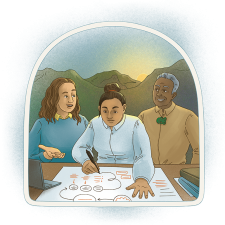3. Planning | Te whakamahere
Tē tōia, tē haumatia.
Nothing can be achieved without a plan, a workforce and a way of doing things.
On this page
 This chapter provides insights on:
This chapter provides insights on:
- Designing transition processes
- Understanding the system
- Developing a shared vision and values
- Communicating with others
In this section
Designing transition processes
How people organise their work together can be structured in different ways, reflecting the diverse contexts in which transitions arise.
Understanding the system
Systems thinking makes sense of the complexity of the world by looking at the linkages and interactions between parts, rather than by studying parts individually.
Developing a shared vision and values
Working together to identify a shared vision and values can help a diverse group choose a common direction.
Communicating with others
From the start of your transition process, you need to think about how you will communicate about it with people both inside and outside the process – especially those that will be affected by it.

